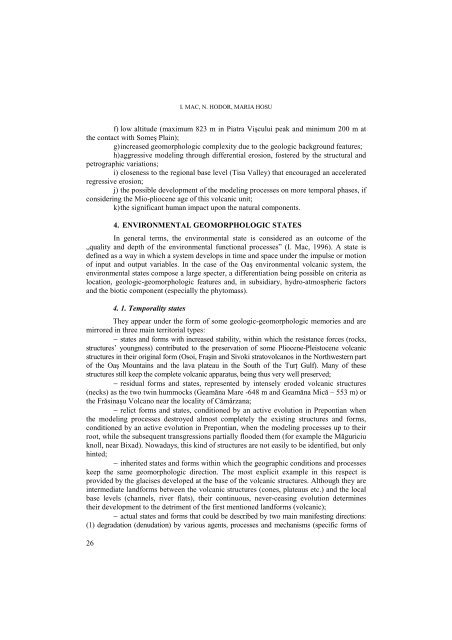geographia - Studia
geographia - Studia
geographia - Studia
You also want an ePaper? Increase the reach of your titles
YUMPU automatically turns print PDFs into web optimized ePapers that Google loves.
I. MAC, N. HODOR, MARIA HOSU<br />
f) low altitude (maximum 823 m in Piatra Vişcului peak and minimum 200 m at<br />
the contact with Someş Plain);<br />
g) increased geomorphologic complexity due to the geologic background features;<br />
h) aggressive modeling through differential erosion, fostered by the structural and<br />
petrographic variations;<br />
i) closeness to the regional base level (Tisa Valley) that encouraged an accelerated<br />
regressive erosion;<br />
j) the possible development of the modeling processes on more temporal phases, if<br />
considering the Mio-pliocene age of this volcanic unit;<br />
k) the significant human impact upon the natural components.<br />
26<br />
4. ENVIRONMENTAL GEOMORPHOLOGIC STATES<br />
In general terms, the environmental state is considered as an outcome of the<br />
„quality and depth of the environmental functional processes” (I. Mac, 1996). A state is<br />
defined as a way in which a system develops in time and space under the impulse or motion<br />
of input and output variables. In the case of the Oaş environmental volcanic system, the<br />
environmental states compose a large specter, a differentiation being possible on criteria as<br />
location, geologic-geomorphologic features and, in subsidiary, hydro-atmospheric factors<br />
and the biotic component (especially the phytomass).<br />
4. 1. Temporality states<br />
They appear under the form of some geologic-geomorphologic memories and are<br />
mirrored in three main territorial types:<br />
− states and forms with increased stability, within which the resistance forces (rocks,<br />
structures’ youngness) contributed to the preservation of some Pliocene-Pleistocene volcanic<br />
structures in their original form (Osoi, Fraşin and Sivoki stratovolcanos in the Northwestern part<br />
of the Oaş Mountains and the lava plateau in the South of the TurŃ Gulf). Many of these<br />
structures still keep the complete volcanic apparatus, being thus very well preserved;<br />
− residual forms and states, represented by intensely eroded volcanic structures<br />
(necks) as the two twin hummocks (Geamăna Mare -648 m and Geamăna Mică – 553 m) or<br />
the Frăsinaşu Volcano near the locality of Cămârzana;<br />
− relict forms and states, conditioned by an active evolution in Prepontian when<br />
the modeling processes destroyed almost completely the existing structures and forms,<br />
conditioned by an active evolution in Prepontian, when the modeling processes up to their<br />
root, while the subsequent transgressions partially flooded them (for example the Măguriciu<br />
knoll, near Bixad). Nowadays, this kind of structures are not easily to be identified, but only<br />
hinted;<br />
− inherited states and forms within which the geographic conditions and processes<br />
keep the same geomorphologic direction. The most explicit example in this respect is<br />
provided by the glacises developed at the base of the volcanic structures. Although they are<br />
intermediate landforms between the volcanic structures (cones, plateaus etc.) and the local<br />
base levels (channels, river flats), their continuous, never-ceasing evolution determines<br />
their development to the detriment of the first mentioned landforms (volcanic);<br />
− actual states and forms that could be described by two main manifesting directions:<br />
(1) degradation (denudation) by various agents, processes and mechanisms (specific forms of

















